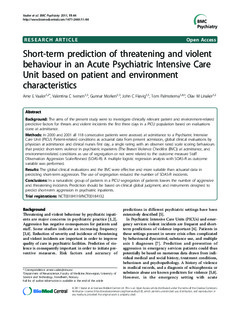Short-term prediction of threatening and violent behaviour in an Acute Psychiatric Intensive Care Unit based on patient and environment characteristics
Vaaler, Arne; Iversen, Valentina Cabral; Morken, Gunnar; Fløvig, John Chr.; Palmstierna, Tom; Linaker, Olav Morten
Journal article, Peer reviewed
Permanent lenke
http://hdl.handle.net/11250/302174Utgivelsesdato
2011Metadata
Vis full innførselSamlinger
Sammendrag
Background: The aims of the present study were to investigate clinically relevant patient and environment-related
predictive factors for threats and violent incidents the first three days in a PICU population based on evaluations
done at admittance.
Methods: In 2000 and 2001 all 118 consecutive patients were assessed at admittance to a Psychiatric Intensive
Care Unit (PICU). Patient-related conditions as actuarial data from present admission, global clinical evaluations by
physician at admittance and clinical nurses first day, a single rating with an observer rated scale scoring behaviours
that predict short-term violence in psychiatric inpatients (The Brøset Violence Checklist (BVC)) at admittance, and
environment-related conditions as use of segregation or not were related to the outcome measure Staff
Observation Aggression Scale-Revised (SOAS-R). A multiple logistic regression analysis with SOAS-R as outcome
variable was performed.
Results: The global clinical evaluations and the BVC were effective and more suitable than actuarial data in
predicting short-term aggression. The use of segregation reduced the number of SOAS-R incidents.
Conclusions: In a naturalistic group of patients in a PICU segregation of patients lowers the number of aggressive
and threatening incidents. Prediction should be based on clinical global judgment, and instruments designed to
predict short-term aggression in psychiatric inpatients.
